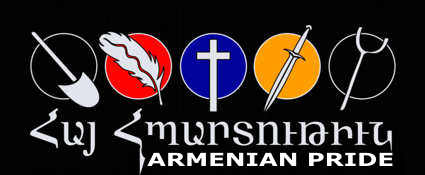|
Armenia
|
|
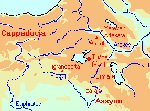 |
Armenia (Akkadian Uraštu;
Old Persian Armina):
ancient kingdom, situated along the river Araxes (modern Aras), the
Upper
Tigris
and the Upper
Euphrates.
For the early history of Armenia, see
Urartu.
Achaemenid Armenia
From the mid-sixth century onward, Armenia was a
satrapy
of the
Achaemenid
empire; how it had become part of the kingdom of the
Persians, is unclear. One possibility is that the earlier
kingdom called Urartu had been subjected to
the
Median
empire, and this may have happened as early as 605, after
attacks by nomads who lived north of the
Caucasus (known to the Greeks as 'Scythians',
Sakesinai or
Cimmerians).
The Medians were overthrown by the Persian king
Cyrus
the Great in 550, and Urartu was annexed by the Persians at
the same time. Alternatively, Urartu retained its independence and was
conquered in
547,
after a direct Persian intervention.
|
|
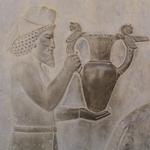
An Armenian on the
East
Stairs of the
Apadana
of
Persepolis. |
However this may be, the country rebelled against its Persian overlords
after
the coup d'état
of the
Magian
usurper
Gaumāta
(or
Smerdis)
had been suppressed by the counter-coup of Darius
I the Great. The new king sent two armies against an unknown
Armenian
leader, commanded by the Persian
Vaumisa
and the Armenian
Dādarši.
Vaumisa managed to secure the road to Armenia on 31 December 522 in a
battle
near Izalā and continued to Autiyāra,
where he won his
second victory on 11 June 521. Both towns are situated on the banks of
the
Greater Zab river. Meanwhile, Dādarši defeated
the Armenians on 20 May 521 near Zuzza, on 30 May at Tigra and on 20
June
at Uyamā. The second name suggests that this second army
moved along
the Upper
Tigris.
These five battles, which are all mentioned in the
Behistun
inscription, meant the end of the uprising. From now on,
Armenia was a
stable
possession of the Achaemenid empire. |
|
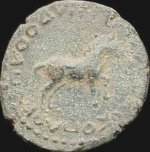
Armenian coin, showing a colt
|
According to the Greek researcher
Herodotus
of Halicarnassus
(ca.480-ca.425), the tribes in the country belonged to the eighteenth
and nineteenth tax districts. Every year, they had to pay five hundred
silver talents. The geographer
Strabo
of Amasia mentions another tax: 20,000 colts.
Under Persian rule, the Urartian language -related to
Hurrian-
was replaced
by Armenian, which was the tongue of the common people. Probably, this
was not caused by ethnic, but by political changes: when the Persians
had conquered the country, they favored the latter
language,
which is related to Greek and -at a distance- Persian.
|
|
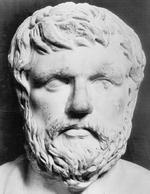
Xenophon |
Although the Armenians seem to have called themselves Haikh,
Herodotus makes in his Histories a distinction
between the Armenians
and Alarodians (a rendering of "Urartians"). He also mentions the
Chaldaioi,
Kolchoi, Makrones, Mares, Moschoi, Mossynoikoi, Saspeires, Tibarenoi (Tabali
in Persian), tribes that lived in Armenia (or in its neighborhood).
Armenia was a tribal society, which means that
the social and political units are
loosely
organized; old tribes disappear as new ones come into being, depending
on the situation. The Athenian author
Xenophon
(ca.430-ca.355) informs us about it in book four of his Anabasis.
He describes at great length how in 401/400 BCE an army of Greek
mercenaries,
which had supported the Persian pretender
Cyrus
the Younger, had to fight its way back from
Babylonia
to the Black Sea
through Armenia.
From the tribes mentioned by Herodotus, Xenophon also
mentions
the
Chaldaioi, Kolchoi, Makrones, Mossynoikoi and Tibarenoi, but
introduces
the Chalybes, Drilai, Kardouchoi and Taochoi.
|
|

A fertile mountain plain between Savsat and Ardahan. |
Herodotus
already knew that Armenia was rich in cattle (Histories,
5.49). Most tribesmen were poor cattle breeders who roamed with their
herds
-sheep, cows, horses- between the summer's and winter's pasture.
Xenophon
mentions no cities, but gives fine description of village live.
[A group of our
soldiers] surprised the
villagers with their
headman, and seventeen colts which were being reared as a tribute for
the
[Persian] king, and, last of all, the headman's daughter, a young bride
only eight days wed. Her husband had gone off to chase hares, and so he
escaped being taken with the other villagers. The houses were
underground
structures with an aperture like the mouth of a well by which to enter,
but they were broad and spacious below. The entrance for the beasts of
burden was dug out, but the human occupants descended by a ladder. In
these
dwellings were to be found goats and sheep and cattle, and cocks and
hens,
with their various progeny. The flocks and herds were all reared under
cover upon green food. There were stores within of wheat and barley and
vegetables, and wine made from barley [i.e., beer]
in great big
bowls; the grains of barley malt lay floating in the beverage up to the
lip of the vessel, and reeds lay in them, some longer, some shorter,
without
joints; when you were thirsty you must take one of these into your
mouth,
and suck. The beverage without admixture of water was very strong, and
of a delicious flavor to certain palates, but the taste must be
acquired.
[Anabasis
4.24-26]
|
|
|
In short, Xenophon's Armenians were a primitive nation, and it comes
as no surprise that Xenophon mentions that their warriors fought with
simple
weapons, such as slings and arrows.
The Persian garrisons, on the other hand, were oases of
luxury. For
example,
somewhere near the
Tigris Xenophon
visited a palace that could be used by the satrap; he saw houses with
storage
towers, which were probably used by the officers (4.4.2). Xenophon
mentions
an artificial road leading toward this settlement (4.3.5). In the
neighborhood
of a second Persian village, Xenophon's men found great supplies of
beef
(a delicatessen), barley, wine, raisins and pods (4.4.9). This is
confirmed
by the archaeological evidence: e.g., wall paintings were discovered at
Arin-Berd.
Independent kingdom
One of the last Persian satraps of Armenia was
Artašata, who became
king of Persia under the name
Darius
III Codomannus (336-330). During his reign, the
Macedonian
king
Alexander
the Great conquered the Achaemenid empire (between 334 and
330), and
Armenia regained its autonomy. (We learn of a new tribe, the Albanoi.)
Several kings are known from this period:
|
|
|
| Orontes II |
c.330
|
| Orontes III |
c.320 - c.280
|
| Samus |
c.260
|
| Arsames |
c.260 - c.230
|
| Xerxes |
c.220 - 212
|
| Orontes |
212 - c.200
|
|
|

Coin of Tigranes II the Great of Armenia, British Museum. |
After
200, parts of Armenia became incorporated in the
Seleucid
empire under king
Antiochus
III the Great. Soon, the country regained its
independence in the form
of two small kingdoms, west and east of the Euphrates. The western
kingdom
was known as Lesser Armenia and ruled by king Zariadris; the other
state
was called Greater Armenia and ruled by Zariadris' son Artaxias
(189-164). The latter rebuilt -following an advice of his
Carthaginian
friend
Hannibal-
Yerevan in 188, called it Artaxata, and made it his capital.
The younger capital Tigranocerta was built by a
descendant of Artaxias,
Tigranes
II the Great (ruled c.95-c.55), who had been able to reunite
Armenia and briefly ruled over the entire East,
but was defeated by the Roman generals Lucullus in 69 and Pompey in 66
BCE.
|
|
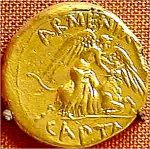
"Armenia Capta": Roman coin, commemorating Trajan's temporary conquest. |
Armenia between Rome and
Parthia
From now on, Armenia was one of the
battlegrounds between the Romans and the Parthians,
who had replaced the Seleucids in what is now Iraq. Several Roman
commanders, like Crassus (53 BCE) and Marc Antony (36) attempted to add
Armenia to the Mediterranean Empire in order to have a bulwark against
the Parthians. The latter came close to success: king Artavasdes II
submitted to Rome and Armenians fought for Marc Antony at
Actium.
As is well-known, Marc Antony and his wife
Cleopatra VII Philopator
met their end in 30 BCE, and their son Alexander Helius, who was
supposed to be king of Armenia, never ascended to the throne. Instead, a
son of Artavasdes II, Artaxes, became king, only to be replaced by
Tigranes III by order of
Augustus' general
Tiberius
in 20.
|
|
| |
Dynastic quarrels forced Rome to intervene several
times. At the
beginning of our era, it was Augustus' grandson
Gaius
Caesar who invaded Armenia. The situation remained
chaotic, because both Rome and Parthia
tried to gain control of this fertile country. But slowly, an agreement
was growing that the Euphrates was to be the frontier between the
mutual zones of influence. Lesser Armania, west of the
Euphrates, was included
in the
province
of
Cappadocia,
but Greater Armenia remained independent.
According to a treaty that had been concluded by
Augustus
and his Parthian colleague Phraates IV, the Romans had the right to
appoint
the Armenian kings. However, in 54 CE the Parthian king
Vologases
I, using an internal crisis in Armenia and a change of government in
Rome, installed his brother Tiridates as king of Armenia.
This deliberate provocation led to war, and to the sack of Artaxata in
58 by the Roman commander
Corbulo.
Tiridates was forced to go to Rome to be crowned by the young emperor
Nero.
Slowly, Rome was increasing its influence, and when
Vespasian
had added Commagene to the empire, a legionary base was created in
Satala,
controlling access to Armenia. As a rule, the Romans were permitted to
select a king from a member of
the royal family, which, through Tiridates, was originally Parthian.
However,
the country was briefly occupied by the Roman emperor
Trajan
between 114 and 117 CE. His successor
Hadrian
gave up the conquests.
Generally speaking, the second century was quiet,
although in 161-165, the Parthians and Romans went to war again. The
Parthians were defeated by
Lucius
Verus,
and Rome's power increased even more, but Armenia retained its
independence, although from now on, it was Rome's loyal ally against
Parthia. For instance, when
Septimius
Severus attacked the Parthian capital
Ctesiphon,
Armenian soldiers were in his army. They had little alternative,
because Severus had added
Mesopotamia
to the empire, which meant that all roads between Armenia and the south
were now controlled by Rome.
| Artaxias |
c.189 - c.164
|
| Tigranes I |
c.164 - ?
|
| Artavasdes I |
? - c.95
|
|
Tigranes
II the Great |
c.95 - c.55
|
| Artavasdes II |
55 - 34
|
| Artaxes |
34 - 20
|
| Tigranes III |
20 - c.8
|
| Tigranes IV |
c.8 - 1 CE
|
| Artavasdes II |
[pretender]
|
| Ariobarzanes |
c.2 - c.4
|
| Artavasdes III |
c.4 - c.6
|
| Tigranes V and Erato |
c.6 - ?
|
| Interregnum |
|
| Artaxias |
18 - c.34
|
| Vonones |
[pro-Roman, Parthian pretender]
|
| Arsaces of Parthia |
c.34 - 36
|
| Mithridates of Iberia |
36 - 51
|
| Radamistus |
[pretender]
|
| Tiridates |
51 - 59
|
| Tigranes VI 'the Cappadocian' |
59 - 62
|
| Tiridates (restored) |
63 - 75
|
| Axidares |
c.110
|
| Parthamasiris |
113 - 114
|
| Sanatruces |
c.115
|
| Roman province |
114 - 117
|
| Vologases |
117 - c.140
|
| Unknown |
|
| Pacorus |
161 - 163
|
| Sohaemus |
164 - c.175
|
| Unknown |
|
| Tiridates II |
c.215
|
| Unknown |
|
| Tiridates III |
c.287 - 330
|
|
|
|
Armenia between Rome and Persia
In the second quarter of the third century, the Parthian Empire was
replaced by the Persian Empire of the
Sasanian
dynasty, a more aggressive power than its predecessor. Several times,
the Sasanians attempted to add Armenia to their possessions, but they
were
repulsed by Armenian kings and Roman generals, although
often with great difficulty. The situation was restored to Rome's
advantage again by the emperor
Carus.
Meanwhile, a religious shift was taking place: Christianity was
spreading throughout the East. Although the Armenian Church has claimed
that it was founded by the apostles Thaddeus and
Bartholomew, the
first missionaries appear to have visited the country along the
Araxes much later. The breakthrough was in the year 303, when Gregory
the Illuminator (257-325) converted Tiridates III. For the first time
in history, an entire state became Christian. (The
Roman emperors Diocletian
and
Galerius,
who were persecuting the new
faith, will not have appreciated this.) The Armenian Church has
remained independent and does not accept several decisions of the
Ecumenical
Councils.
In the second half of the fourth century, the Sasanian king Shapur II
was able push back Rome, and gained influence in Armenia, which was
recognized by the Roman emperor
Theodosius
in 384, when he signed a treaty with Shapur's son Shapur III. In 428,
the Romans and Persians divided the ancient kingdom. Its traditions
survived in the Armenian Church. |
|
| |
Note
The table of kings is based on E.J. Bickermann, Chronology of the Ancient World
(1980²).
|
© Jona Lendering for
Livius.Org,
1998
Revision: 21 October 2007 |
|

